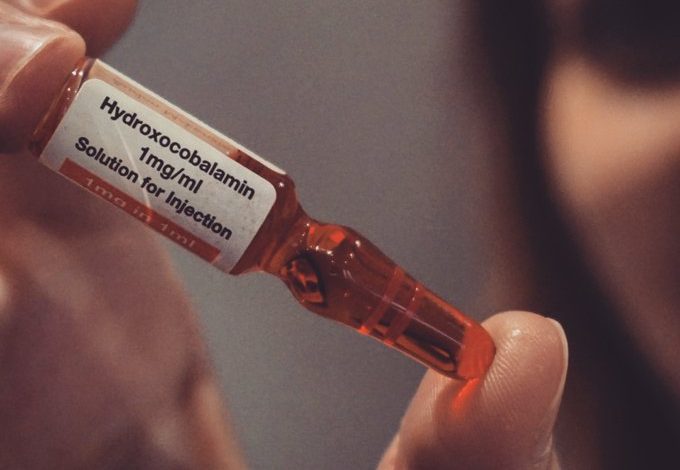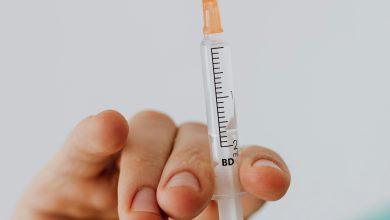How To Give Vitamin B12 Injections

Cyanocobalamin is a manufactured version of vitamin B12, it belongs to a class of medications called vitamins. This injection is used to treat and prevent vitamin B12 deficiency anemia that may be caused by any of the following: pernicious anemia (lack of a natural substance needed to absorb vitamin B12 from the intestine); certain diseases, infections, or medications that decrease the amount of vitamin B12 absorbed from food; or a vegan diet (a strict vegetarian diet that does not allow any animal products, including dairy products and eggs).
Lack of vitamin B12 may cause anemia (a condition in which the red blood cells do not bring enough oxygen to the organs) and permanent damage to the nerves. Vitamin B12 injection also may be given as a test to see how well the body can absorb vitamin B12. Because it is injected straight into the bloodstream, it can be used to supply vitamin B12 to people who cannot absorb this vitamin through the intestine.
Vitamin B12 injection is also sometimes used to treat inherited conditions that decrease the absorption of vitamin B12 from the intestine. Vitamin B12 injection is also sometimes used to treat methylmalonic aciduria (an inherited disease in which the body cannot break down protein) and is sometimes given to unborn babies to prevent methylmalonic aciduria after birth. Talk to your doctor about the possible risks of using this drug for your condition.
How to give Vitamin B12 injections
Vitamin B12 comes as a solution (liquid) to be injected into a muscle or just under the skin. It is usually injected by a healthcare provider in an office or clinic. You will probably receive a Vitamin B12 injection once a day for the first 6-7 days of your treatment. As your red blood cells return to normal, you will probably receive the medication every other day for 2 weeks, and then every 3-4 days for 2-3 weeks. After your anemia has been treated, you will probably receive the medication once a month to prevent your symptoms from coming back.
Vitamin B12 injections can be administered as intramuscular or subcutaneous injections. The difference between the two is that intramuscular injections are inserted into the muscle, and subcutaneous injections are inserted just below the skin.
An intramuscular injection is absorbed faster because the muscle tissue has more blood supply. However, it means that this method may be more painful and may cause swelling and redness. The advantage of subcutaneous injection is that it is easier to learn at home and less painful. Additionally, a subcutaneous injection uses a shorter needle because it does not need to go deep into the tissues.
However, the manner of administering the injection may change depending on the amount of fat under your skin. You can decide which method to choose depending on which one is more comfortable for you.
Vitamin B12 injection will supply you with enough vitamin B12 only as long as you receive injections regularly. You may receive Vitamin B12 injections every month for the rest of your life. Keep all appointments to receive Vitamin B12 injections even if you feel well. If you stop receiving Vitamin B12 injections, your anemia may return and your nerves may be damaged.
Where to Inject Vitamin B12
Learning to inject at different injection sites will be helpful, as repeated shots at the same location will be unhealthy for your skin.
For intramuscular injections, the common sites for B12 injections are the arm, upper buttocks, and thigh. Subcutaneous injections can be administered at the side or back of the upper arm, lower abdomen, and front of the thigh. If you have a friend or loved one to help you, the upper buttocks or the arm are a good choice. On the other hand, if you are self-administering, then the thigh is a more convenient location.
Whichever method or injection site you decide on, you should keep your hands and supplies sanitized. First, clean the injection area you choose with alcohol and allow it to dry. Do the same for the top of the vial of your vitamin B12 solution. Draw vitamin B12 from the vial into your syringe. Make sure there is no air trapped inside and no blood when you pull on the syringe slightly.
If you choose to inject intramuscularly, insert the needle at a 90-degree angle. For subcutaneous injections, pinch the fat and insert the needle into the fat under the skin. After injection, apply pressure on the site where you injected B12.
To ensure a safe and successful administration of your vitamin B12 injection, consult your doctor for detailed instruction or demonstration.
Side effects of B12 Injections
Like all medicines, vitamin B12 injections can cause side effects in some people, but not everyone gets them.
Common side effects
Talk to your doctor if any of these side effects bother you or do not go away after a few days:
- diarrhea
- feeling dizzy
- feeling or being sick (nausea or vomiting)
- headaches
- hot flushes
- pain, swelling, or itchy skin where your injection was given
Serious side effects
Serious side effects are very rare but tell your doctor immediately if you get any of these symptoms after having treatment:
- irregular heartbeats or heartbeats that suddenly become more noticeable (palpitations)
- Serious allergic reaction
In rare cases, vitamin B12 injections can cause a serious allergic reaction (anaphylaxis).
Request for emergency medical assistance if:
- you get a skin rash that may include itchy, red, swollen, blistered, or peeling skin
- you’re wheezing
- you get tightness in the chest or throat
- you have trouble breathing or talking
- your mouth, face, lips, tongue, or throat start swelling
You could be having a serious allergic reaction and may need immediate treatment in the hospital.
These are not all the side effects of vitamin B12 injections. For a full list, see the leaflet inside your medicines packet.
How to cope with vitamin B12 injections side effects
What to do about:
- Pain, swelling or itchy skin where your injection was given – these symptoms are usually mild and should only last a few hours. You can ask a pharmacist to recommend a mild painkiller if the pain is bothering you.
- Feeling or being sick – stick to simple meals and avoid rich or spicy food. If you’re being sick, try small, frequent sips of water to avoid dehydration.
- Diarrhea – drink plenty of fluids, such as water or squash, to avoid dehydration. Signs of dehydration include peeing less than usual or having dark strong-smelling pee.
- Headaches – make sure you rest and drink plenty of fluids. do not drink too much alcohol. Ask your pharmacist to recommend a painkiller. Talk to your doctor if the headaches are severe or last longer than a few days.
- Feeling dizzy – stop what you’re doing, and sit or lie down until you feel better. Do not drive, ride a bike, or use tools or machinery until you stop feeling dizzy.
- Hot flushes – try cutting down on coffee, tea, and alcohol. It might help to keep the room cool and use a fan. You could also spray your face with cool water or sip cold or iced drinks. The flushing should go away after a few days. If it does not go away, or if it’s causing you problems, contact your doctor.





